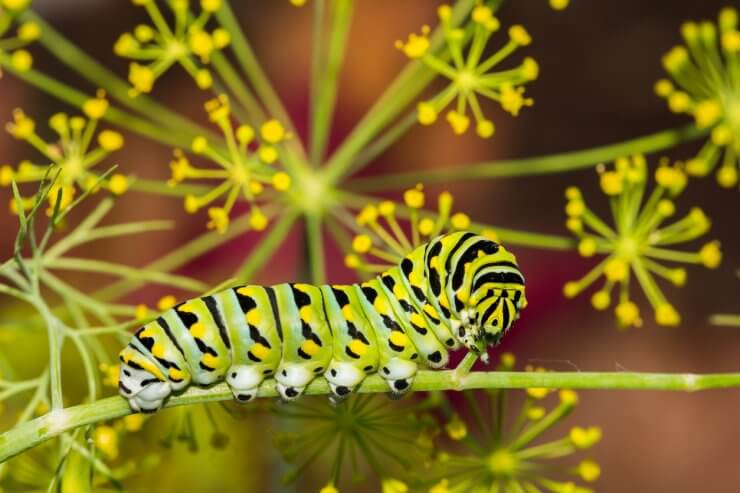
Black swallowtail caterpillar on dill, also known as a Parsley Worm
Fortunately, not many pests bother dill, and those that do are easily managed. Keeping a close watch on your plants during regular daily inspections will help you spot any pests before they can do irreparable harm. Healthy dill plants can bounce back from pest damage if you catch the pests quickly.
Spot the symptoms of dill pests
Check leaves, branches, and heads for these symptoms that come from pests on the prowl!
On Dill Leaves and Branches
| Symptom | Pest | Treatment |
| Yellowing leaves; clusters of small “bumps” on underside of leaves | Aphids | Dill flowers attract ladybugs which eat aphids. If dill isn’t in bloom, introduce ladybugs. |
| Foliage loss | Parsley worms | Parsley worms turn into Black Swallowtail butterflies. Pick off worms and place them elsewhere in the yard. |
| Foliage loss | Armyworms | Pick off and drop in soapy water or apply Bacillus thuringiensis. |
How to treat pests on dill plants
Here is some more information on proven ways to get rid of pests on your dill plants. Choose the best treatment for the type of pests invading your plants.
- Pick off the pests. Use your garden gloves to remove the pests by hand. After removal, destroy pests by drowning them in a bucket of soapy water or crushing them with your foot. Handpicking isn’t efficient or practical for very small pests but works well with larger pests.
- Apply insecticidal soap. Insecticidal soap is organic. The potassium salts in insecticidal soap help remove an insect’s protective waxes, causing destruction of insect membranes and killing them. Mix the soap with water to create your solution and apply directly to insects on any plants. While insecticidal soap is less apt to affect other organisms, certain plants might be sensitive to the soap and can suffer leaf burn.
- Apply horticultural oils. Combine plant- or petroleum-based oils with water to produce horticultural sprays. Neem oil, for instance, is derived from seed extracts of the neem plant. Oil-based sprays block an insect’s air holes, interfere with an insect’s metabolism, disrupt insect feeding, and inhibit insect growth. Like insecticidal soaps, horticultural oils can cause plant injury if not properly diluted.
- Make your own pest spray. You can make your own pest spray with benign materials. Mix one tablespoon of baking soda, 1/2 teaspoon of a mild dish detergent, and 2 1/2 tablespoons of olive oil in a gallon of water to make a solution that will repel all kinds of bugs, as well as a fungicide for blight and mildew on the dill plant leaves. Shake it well in your bottle before spraying and repeat every week for it to be continuously effective.
Do pests attack your dill plants every year? How do you handle removing them—and even preventing them in the first place? Please tell us how you treat your dill plants to avoid pests.


 Previous
Previous

